(Updated:
March, 2020) All
literature & photo's copyrighted & protected by worldwide copyright laws.
My
fascination with the Detroit two cycle engines started when my father traded a old International Harvester LB stationary farm engine for a Detroit engine
around the 1990 time period. At the time I don't believe dad new that he
had traded for one of the very first low pressure fuel injected engines
first invented in the early 1900's. After my father spent some time studying the
engine and figuring out how the fuel system operated the engine was then
completely restored. I remember the first time I seen the little Detroit
engine run I knew I had to have one. I never seen a two cycle engine that would
start so easy, run so good and was not loud and noisy. It would idle down
and run as slow as a four cycle engine and you could even reverse the direction the engine
was running with out stopping the engine. Changing the direction is done
by slowing the engine to a very slow idle turning the ignition off and
quickly advancing the timing then turning the ignition back on. This made the engine kick back in the opposite direction in
which it would keep running if you quickly moved the timing lever back
to neutral or top dead center.
Some time between 1997 and 1998 I came across a 3hp Detroit that was for sale at our local
antique engine swap meet. It was missing a few parts but I did not hesitate in
purchasing the engine. This is when I first started collecting
literature on DEW. Over the next few years I became
more fascinated with the Detroit Engines and the companies history. Little did I know that I would
end up researching and learning about many other companies in order to put some of the pieces of this puzzle together. Also
researching information on marine engines which at the time
I had very little interest in. There were so many un-answered questions
about these engines and the companies that manufactured them. I guess
that is what has kept my interest over the years. I now own 12 of
the Detroit Engines, As the
years have passed by I have become even more interested in learning about Detroit Engine Works and its related companies. On this website you will find original literature
and photos along with information that I have figured out from reading
literature studying engines and photos. Most of the information
has been gathered from original literature and should be fairly
accurate. As time goes by I'm sure that more information will
surface on Detroit Engine Works and it's related companies.
Most are not aware of these
old gas engines and the roll that they played in our great nation here
in USA and all over the world. On this website you will read about and
see photos of some of the very early gas engines that were in some cases
developed
before the first gas powered automobiles. Gas powered Marine
engines were being used all over the world in every size boat you could
imagine. The stationary engines were
used to power farm machinery such as corn grinders, water pumps, saw
mills, cream separators, butter churns, ice cream churns, washing machines, light plants, concrete
mixers, hoist, tractors, Etc.. I have added the
two paragraph
below to this history page because I feel that most people may not be
aware that it was the early Detroit marine & stationary engine companies and
their employees that manufactured them who opened the doors for the
Detroit automobile industry. Below are quotes
from two different books from author's that talk about the important roll
that the early gas engines and the people who manufactured them played
in our history.
The City of Detroit Michigan 1701-1922, by Clarence M. Burton.
Published 1922
"The rapid and immense growth of the automobile industry in Detroit was not accidental. The
chief honor for this development goes to the men of southern Michigan who had the courage and ambition to take hold of
the new idea and see it through.
Although many other cities had equal facilities as a shipping port, Detroit was the possessor of other advantages which aided materially in the growth of the bussiness of automobile
making. Michigan was, at the early stages, manufacturing more marine gas
engines than any other state in the country, and Detroit itself had more expert
gas engine workers than any other city. It was not necessary to import or to
train this important class of skilled workers. They were already at hand.
Michigan surpassed every other state in the manufacture of carriages, buggies
and wheels. It's workers in this line could immediately adapt their plants to
the making any style of body or tonneau for the automobile."
Motormen & Yachting by author Michael M. Dixon.
Published 2005
"The
marine gas engine business may not be recognized as a great industry
when compared to the automobile. However, as late as 1910, Gas Engine
magazine observed that while much attention was being given to
impressive numbers of automobiles being produced, the largely invisible
gasoline marine engine still out numbered automobile engines in use by a
factor of two to one. It was the impressive number of marine gas engines
that prepared a generation of mechanics to establish Detroit's
automobile industry."
________________________________________________
March 1909 Popular
Mechanics Advertisement.

Detroit
Engine Works
offices and factories were located
on East Jefferson Ave in Wayne County Detroit, Michigan northwest
of the Detroit river. Detroit Engine Works was just one of several
companies that was owned & operated by Wadsworth manufacturing Co.
Other companies included
were Detroit Motor Car Supply
Co. (Sandow), Columbia Engine Co.
Detroit Boat Co. and Michigan Steel Boat Co. Addresses on original literature & phone
books indicate that Wadsworth Mfg Co. had multiple properties and
buildings ranging in a span of five blocks between Mt. Elliot Street and
Canton Street on
the north side. South side properties and buildings span two blocks
between Mt. Elliot St. and Meldrum Street. Later around 1915 time period
Wadsworth Mfg. purchased land in the area of East Jefferson, Conner Creek
& Kercheval Street. All these areas were excellent
locations for the factories because ore and coal for the foundry could be
shipped in by way of boat on the Detroit river or the railroad. The railroad was
very close to the factories which made it great for shipping. Wadsworth Mfg Co.
manufactured
and sold carriage goods and hardware and eventually manufactured auto bodies, auto tops, auto parts and was located in the same
facilities. Wadsworth
Mfg was supplying car bodies to many of
Detroit
’s automakers including Ford and Wadsworth’s three neighbors, Hudson, Maxwell & Chalmers.
It is stated that Wadsworth Mfg and their Detroit
Engine companies owned and
operated their own foundry (Detroit Forging Co.) but trademark casting symbols
on the Detroit engines prove that a few other foundry companies were
also helping to produce castings for the Detroit engines such as
Fairview Foundry company in the village of Fairview located between
Detroit city & Grosse Pointe Park right on the Detroit river on Vanilla
Avenue. Another unidentified trademark symbol the letter "A"
with a oval circle around it were cast into the Detroit Motor Car Supply
Company (Sandow) engines crank cases. It was not unusaul for engine
companies to sometimes use other companies to help produce parts for
their engines. DEW, DMCSC, DBC, CEC, MSBC advertized that
they were the
largest manufactures of engines and pleasure boats in the world.
__________________________________________________________________________________
All
literature & photo's copyrighted & protected by worldwide copyright laws.

Photo
taken sometime between 1906-1914 courtsey of
Burton Historical
Collection Detroit Public Library.
Photo
above is of the older Wadsworth Mfg. Co. show room at 1256 East Jefferson Ave. located on the south side of Jefferson
Ave. across the street from their newer factory and closer to the Detroit river. The four story building to the left of the show
room was also part of the Wadsworth factory. The steel rails in the road were for
electric street cars. Click on the photo to enlarge
and notice the boats, engine and coach bodies that are on display through the plate glass windows.
Sign on the side of the building shows the direction of the Morgan
& Wright Tire Co. behind the show room. Originally from
Chicago, the Morgan & Wright Bicycle Tire Co., moved to Detroit
in 1906 and built it's 900,000 sq ft complex on a portion of the former Old's Motor Works parcel,
east of the Wadsworth
plant.
Below is 1914
advertisement for Detroit Boat company advertising their famous show window on Jefferson Ave.
New street address for the Wadsworth Mfg. Co. show room now would be
6656 East Jefferson Ave. The old Morgan & Wright Tire Co. was sold
to US. Tire Co. in 1914 and then later became Uniroyal Tire Co.. In 1980
Uniroyal announced it would be closing down the riverfront plant. Later
that year the City of Detroit purchased the Uniroyal plant and land in
hope of developing the river front property. The Uniroyal buildings were
completely demolished in 1985. Today the still vacant land offers a
clear view of the river and Belle Isle. The city of Detroit is currently
in the process of building a river walk all the way from Mt. Elliott St.
to Grand Blvd.- Belle Isle bridge.

Detroiter Magazine, Volume 5
& 6, 1914.
_______________________________________________________________________________________
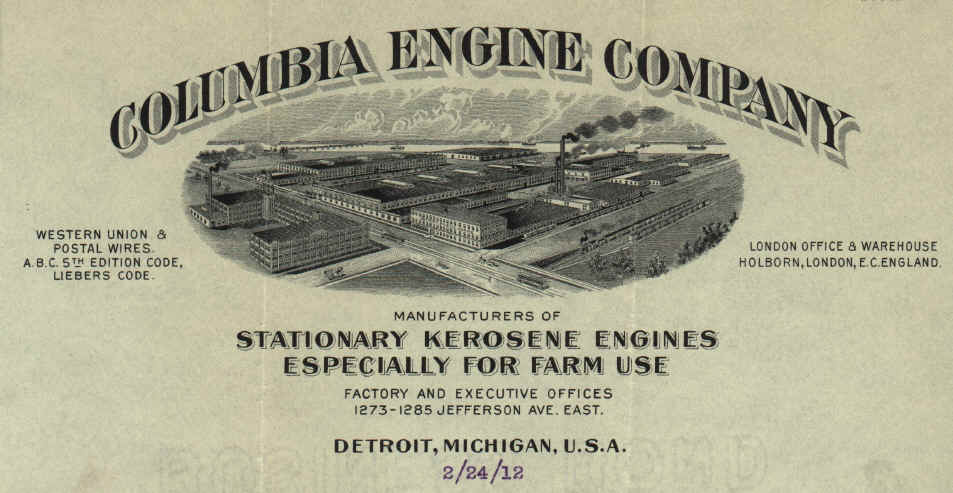
DEW had distributorships in London England located at 94 Hatton Garden and another office & warehouse about 15 miles away at Holborn. The Holborn office & warehouse was advertised as the Columbia Engine Company with their main
offices located at 1273-1285 East Jefferson Ave. Detroit, Michigan. Very little is known about
the London dealerships.

____________________________________________________________________________________
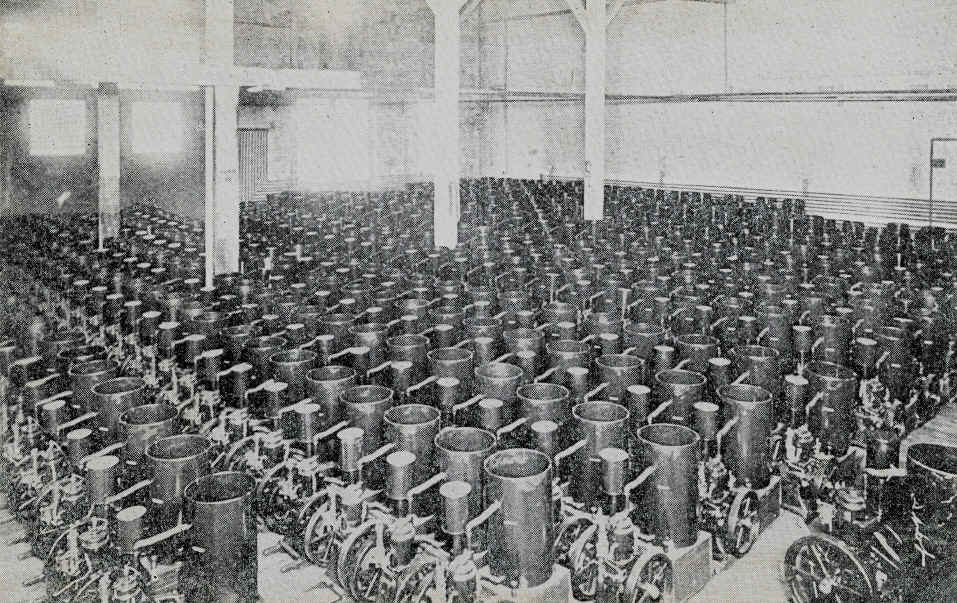
Detroit Engine Works stationary engines at the Detroit factory.
____________________________________________________________________________________
H.
Scherer & Co. establishes the Detroit Motor Car Supply Co. 1904. Hugo Scherer
(b.1859-d.1923), a major stockholder
in the Wadsworth Manufacturing Co., was the person most responsible for
the firm’s entry into manufacturing automobile bodies.
Scherer was born in October 9, 1859, in Detroit,
Michigan
to Augusta and John Conrad Scherer, two German immigrants from the state
of Hessen. In 1851 the elder Scherer (sometimes misspelled as Shearer),
who was a physician, established an apothecary in downtown Detroit
at 39 Michigan Ave East., near the old county office building. Hugo obtained his early education
in the public schools of
Detroit
and after graduation went to
Europe
where he spent six years at University.
Upon his return to the states, Scherer went to
work in his father’s drug store, eventually taking charge of the
business, which he inherited upon the death of his father. Hugo’s
younger brother, Otto Scherer (b.1865) decided to pursue a career in
medicine and after a lengthy course of study became a prominent Detroit
physician.
By 1879 Scherer’s pharmacy had relocated to 280-284 E. Jefferson Ave.
The firm’s spacious new quarters allowed them to get into the hardware
and carriage goods business, which by the mid 1880s had become their
specialty. By 1887, the renamed firm, H. Scherer & Company, was the
city’s main source of wholesale carriage hardware and had begun the
manufacture of their own line of carriage dashboards. Subsequent
directories list the firm as a manufacturer and distributor of carriage
drop forging, hardware and trimming material.
The carriage business must have been profitable as
Scherer had enough capital to purchase other firms as evidenced by the
following 1905 news item:
“H. Scherer & Co.,
Detroit,
Mich., have purchased the building and stock of the defunct James & Mayer
Carriage Works,
Lawrenceburg
,
Ind., for $27,000.”
Hugo also owned a mansion at 745 E. Jefferson Ave.
and in 1898 commissioned
Detroit
architect Louis Kemper to design and build him a magnificent summer
residence at Grosse Pointe Farm, the summer home of his friend Frederick
E. Wadsworth.
An early automobilist, Scherer was a founding
member of the Detroit Automobile Club, which was formed in 1902.
Although they shared the same name,
Detroit’s Hugo Scherer was not directly related to the infamous Mexican
bankers, Hugo Scherer Sr. & Hugo Scherer Jr. of Mexico City
.
As the automobile came of age, H. Scherer &
Co. discovered that the very same items were needed by Detroit’s automobile industry. A 1904 issue of the Automobile Trade Journal
reported that:
“H. Scherer & Co., of Detroit, Michigan., makers of bodies, etc., have incorporated under a new style and had
planed on confining the business entirely to the automobile. Their new company was called the
Detroit Motor Car Supply Company
and the office and factory was located at 1256 Jefferson Avenue
. They are putting up a large building, 80 x 1000 feet, and will make
wood and metal bodies, tops, eye protectors, lap robes and
clothing.”
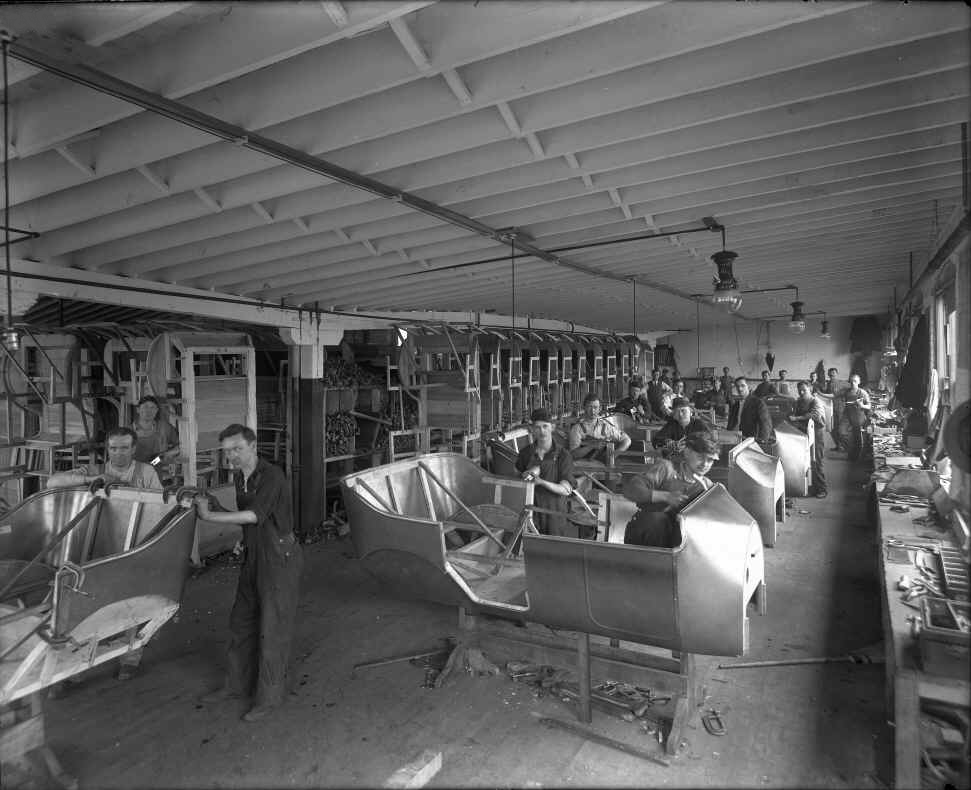
All
literature & photo's copyrighted & protected by worldwide copyright laws.
DMCSC new cinder block building was constructed between Bellevue
Street and Concord Street at the corner of Jefferson Ave. and Bellevue Street.
current address would be 6601 East Jefferson Ave. were there is now a Wendy's hamburger fast food business. (Jefferson Ave. was
re-numbered in 1921).
It has been stated that a very old building that is currently located at 6533
East Jefferson Ave. is the old Detroit Motor Car Supply Co. building and
that it is still in use today as an apartment building called (The Lofts at
Rivertown). This is a false statement. The building located at 6533 East Jefferson is not the
old Detroit Motor Car Supply Co. building. It is the old Frederick Stearns
& Company building built in 1899. Photos exist of this building Circa
1910-1915 and yes it is currently an apartment building called (The Lofts at
Rivertown).
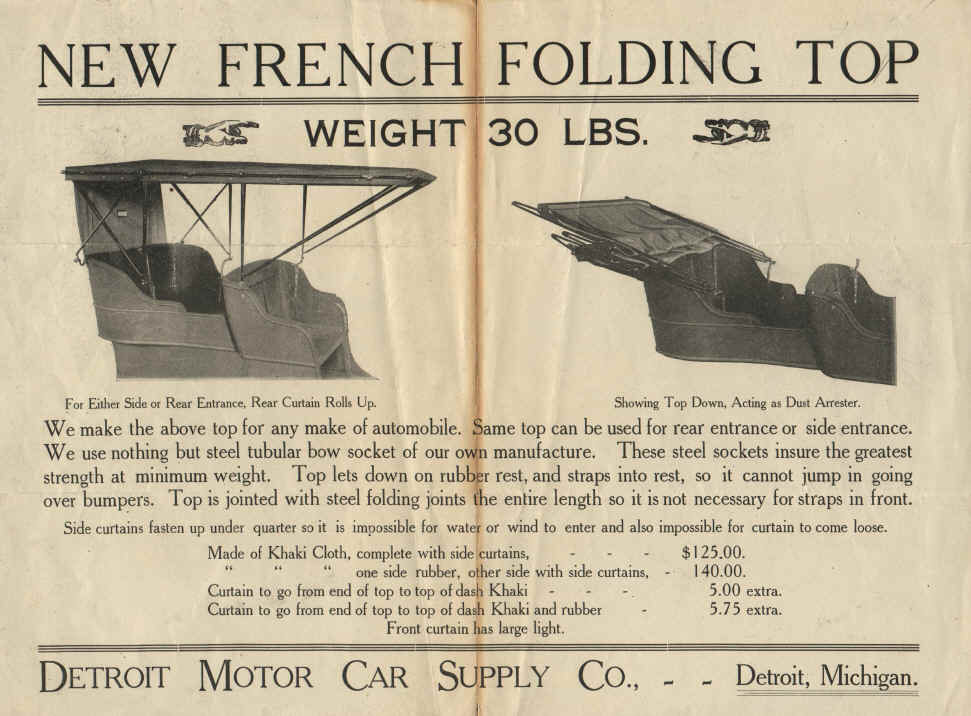
All
literature & photo's copyrighted & protected by worldwide copyright laws.
Detroit Motor Car Supply Co. was listed as
exhibitors at the annual ALAM New York Automobile Show, held at Madison
Square
Gardens
from January 12 to 19, 1907. The previous year’s New York
automobile Show was covered in the Jan 25, 1906 issue of The Automobile
which included the following description of their booth:
"Detroit Motor Car Supply Co. - A large exhibit of automobile
clothing for all weathers, automobile accessories and supplies, was
made. Particularly seasonable were the robes and weatherproof coats
shown. This concern manufactures automobile bodies, tops, tire cases,
clothing, caps, storm aprons, dash clocks, wind screens and other
automobile accessories. The company claims to be the largest
manufacturer of automobile bodies in the United States, and had in the Armory an exhibit of several up-to-date styles of
coupe,
landaulet and limousine bodies. A special runabout top, complete with
side curtains, storm front and body irons, appealed particularly to the
users of small cars."
During the mid-teens Wadsworth Manufacturing
offered a very successful "Full Vision Sedan Top" for Model T
Touring Cars, a lined and insulated top very similar to the all-weather
convertible tops offered by the Springfield Metal Body Co. and others.
In later years Detroit Motor Car Supply Co. was
listed as a manufacturer of commercial bodies for Fords, but around the
1910-1911 time period they were
also manufacturing and distributing two cycle stationary and marine gasoline
engines called "SANDOW". The engines
looked very similar to the DEW engines but did have some differences.
Detroit Motor Car Supply Co. advertised that there engines were not sold
to jobbers, dealers or agents. (Direct plan of selling, No middle man,
straight from factory to user). Savings was passed on to the user.
1913 stationary farm engines.

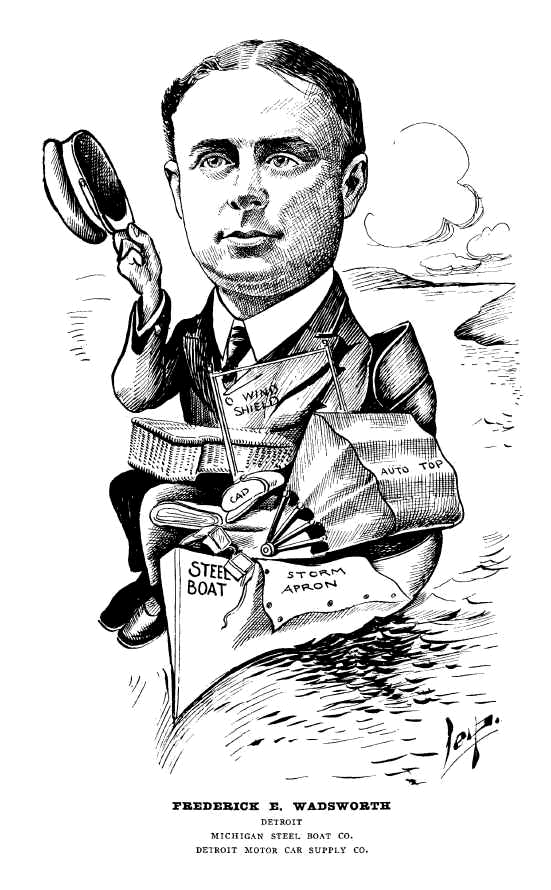 |
The success
of Hugo Scherer’s various business interests can also be
attributed to his friend and business partner, Frederick Elliott
Wadsworth (1868-1927).
Wadsworth
was born in
Durham
,
Middlesex County,
Connecticut
to James W. Wadsworth, a member of one of Connecticut’s
most prominent families. After a public education
Frederick
attended university after which he made his home in Detroit,
Michigan
. Wadsworth
and Scherer organize the Detroit Engine Works in the early 1900's
and Wadsworth
was instrumental in the formation of the National Can Company,
serving on the firm’s board of directors for a number of
years. Surprisingly, National Can’s Detroit
plant produced auto parts in addition to tin cans. Located at 2566 East Grand Blvd.
The firm produced ‘Mayo’ and ‘National’ brand radiators under
the Mayo patents as well as other stamped, sheet-metal auto parts.
National’s radiator business was eventually purchased by the McCord
Radiator & Mfg. Co.
Wadsworth’s experience in metal stamping proved
helpful when he and Scherer got into the boat and auto body building
business and Wadsworth’s deep pockets helped finance the pair’s
business ventures, which included the following: Columbia Engine
Company, Detroit Boat Company, Detroit Engine Works, Detroit Forging
Company, Detroit Motor Car Supply Company, Michigan Steel Boat Company,
St. Clair-Athol Rubber Company and the Thrall Motor Company.
Detroit Engine Works, Detroit Motor Car Supply Co., Columbia Engine Co.
manufactured 2-cycle marine and stationary engines
rated between 2- and 50-hp. Also offered by
Detroit
was a range of light kerosene-powered 6-to 18 hp Wadsworth
farm tractors.
Detroit Forging specialized in drop-forged
automobile parts, specifically convertible top hardware. St. Clair-Athol
Rubber Co. manufactured rubber coated automobile fabrics that were also
used in convertible tops. Michigan Steel Boat
Co. and Detroit Boat Co. manufactured boats which more often than
not were powered by engines manufactured by the Detroit Engine Works.
|
Not surprisingly, all of the above firms were located
either in the same factory or same vicinity of East Jefferson Ave, all
were operated under the auspices of
the Wadsworth Mfg Co. Wadsworth
Mfg Co. was also known for manufacturing automobile bodies, tops, and accessories for
Detroit’s automakers, many of whom were
also conveniently located along East Jefferson Ave.
The Wadsworth
factory was located adjacent to a siding of the Detroit Terminal
Railway, which later on enabled them to get large contracts with the
Ford Motor Co.
Scherer and Wadsworth
organized the Detroit Engine Works in order to manufacture
two-cycle engines for marine and agricultural use. The firm later
produced a large number of products including light tractors, stationary
engines, reverse gears and various other machined, drop-forged and
cast-metal products.
Scherer and
Wadsworth
marketed their engines under the Detroit Motor Car Supply Co. (Sandow),
Detroit Engine Works and Columbia Engine Co. trade names. As early as 1902 the Detroit Engine Works was
using 1256 East Jefferson Ave.
,
Detroit, as their main address however numerous addresses
were used most of which indicated
the same group of structures around the East Jefferson Ave. area (1036,
1236, 1242, 1250, 1252, 1256, 1263, 1271, 1273, 1287, 1314, 1315,
1375). Bellevue Ave. address (24, 66, 115, 171, 187, 213,
417, 361, 373, 420, 445).
Also one address listed at 24 Beaufait Ave. Detroit. Just as it does today, Bellevue
ran alongside the west side of the new (built in 1905) factory/office
building located on the north side of East Jefferson. The firm continued
to use the older factory located across the street on the south side of
East Jefferson until it moved to Conners Creek.
Located at 2700 E. Jefferson Ave.
, just across the street from Wadsworth’s new
plant in the Conner's Creek area was the main factory of the Chalmers Motors Co. Starting
in 1917 Chalmers leased a portion of their facility to the Maxwell Motor
Company for an initial five year contract.
Scherer and Wadsworth
were also partners in real estate. In 1903 they constructed a
neighborhood of frame cottages in the summer resort of Grosse Pointe
which became known as the ‘Cabbage Patch’. In 1916 Scherer formed
the Hugo Scherer Land Co. to manage his various real estate holdings
which included the Scherer Block (
280-284 East Jefferson Ave.
) and a large commercial structure located at 936-944 Woodward Ave.
Scherer and
Wadsworth’s early business ventures shared the same downtown Detroit
address -
280-284 Jefferson Ave
(East) - as Scherer’s carriage supply firm. The pair’s second
recorded business venture, the Michigan Steel Boat Company, was
incorporated on December 27, 1901 with Hugo Scherer, president; and
Frederick E. Wadsworth, secretary-treasurer.
Detroit
Engine Works pioneered the use of two-cycle engines for marine
and stationary power use. Sources indicate that
DEW
started out as a
marine engine manufacturing firm that eventually produced stationary gasoline-kerosene engines, traction engines and reverse
gears and many other products. One style of engine that
DEW produced
was
very unique due to being one of the first low pressure fuel injected
engines invented back in the early 1900's. Manufactured sometime around 1907. This
fuel injected engine was DEW's most popular engines
produced due to the fact that it was designed to run on a multiple types
of fuels. Gasoline, Kerosene (Coal Oil), Alcohol, Naptha, Distillate and
no change in equipment was necessary to change from one fuel to another
unless you wanted to run natural or
artificial gas then a regulator adapter could be purchased. DEW
advertisements claimed that their engines could start and run on most
all fuels and in any climate including 40 degrees below zero temperatures.
A 1910 advertisement in Popular Mechanics magazine stated that 35,000
Detroit engines are in use all over the country and giving the best and
cheapest power ever known.
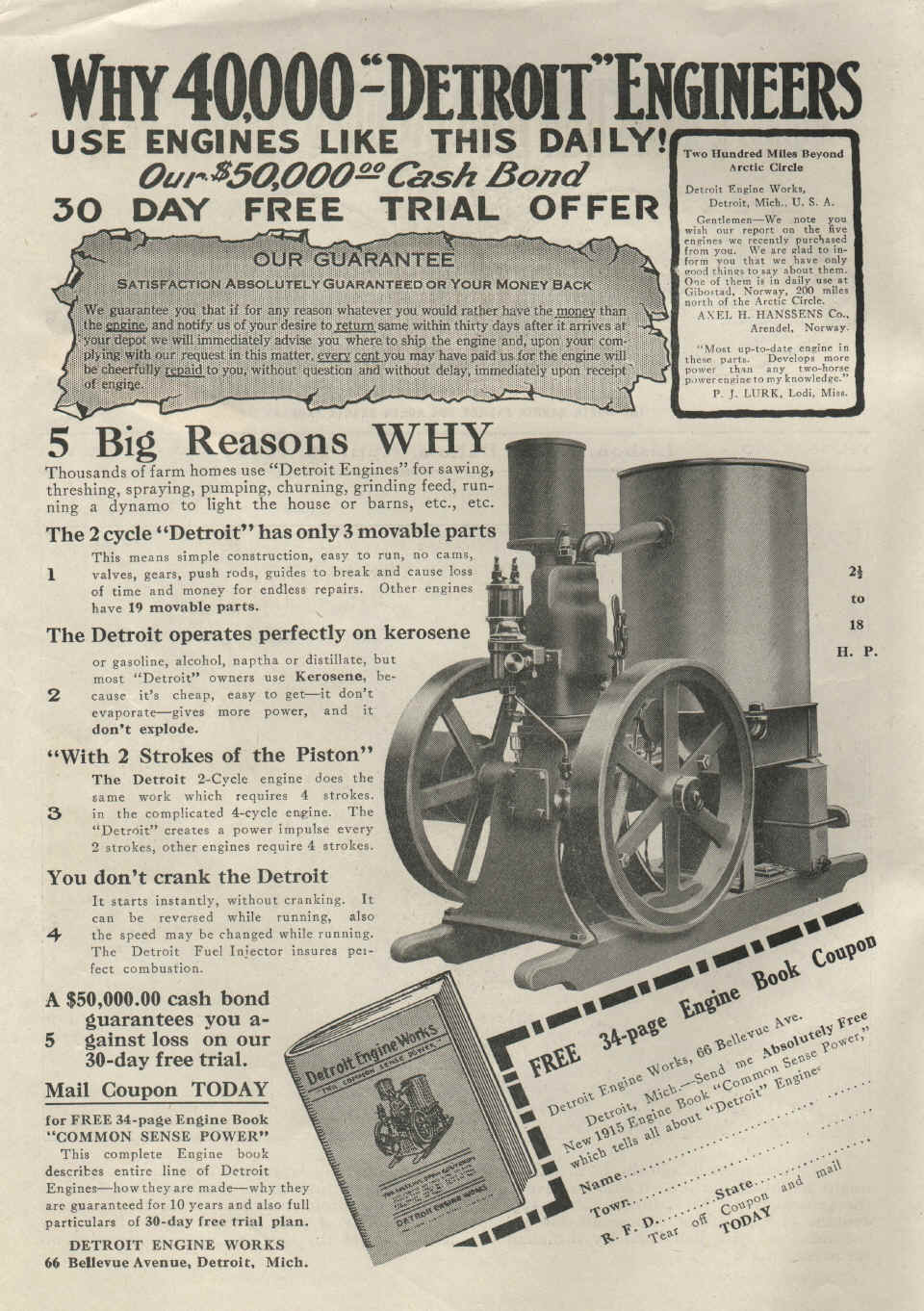
All
literature & photo's copyrighted & protected by worldwide copyright laws.
DEW two cycle single cylinder two flywheel
vertical
stationary engines (tank cooled) were built in size's 2, 2.5, 3,
3.5, 4, 5, 6, 7, 8 horse power. The two cylinder two cycle two
flywheel vertical stationary engines (tank cooled) were built in sizes 12, 18 and
20 horse power. All of the two cycle two flywheel stationary engines were
sold with the low pressure fuel injection systems. Carburetors and mixers
were not advertised for the stationary engines. In the first few years of production original
DEW catalogs advertise their governed stationary engines only up to
8 horse power in size. However they advertise non-governing engines in
sizes 2,3,3.5-4,5-6,7-8,10,12-14,18-20 horsepower. Most of the Non-governing
engines were single flywheel marine engines that came mounted on a
wooden base with a pulley between two pillow blocks.
1915 Detroit Engine Works Stationary farm engine price
list.
|
Horse
Power
|
2.5
hp
|
4
hp
|
6
hp
|
8
hp
|
12
hp
|
18
hp
|
|
Price for 1915
|
$110.00
|
$165.00
|
$220.00
|
$319.00
|
$572.00
|
$1,000.00
|
DEW also sold Single cylinder four cycle
hopper cooled horizontal stationary engines in sizes 1.5, 2, 3, 4.5, 6, 8
horse power. These four cycle stationary engines appear to have been manufactured
by the Nelson Brothers corporation and tagged with DEW
name tags. Some of these engines had (Detroit Engine Works,
Detroit, Michigan) cast in large raised letters on top of the water
hopper.
Research shows that DEW, DMCSC
& Columbia marine engines were offered in many different configurations over the
years. An assortment of carburetors and mixers were manufactured by different
companies, DEW, Schebler, Lunkenheimer, Essex, Krice, Planhard,
Williams are just a
few that are known to have been used. Ben J. Middleditch
manufactured the first fuel injection systems designed by the Peterson
Brothers John & Frederick and were used on the Detroit engines. Then DEW manufactured
their own fuel injection systems, three different styles
of fuel feeder-injectors in the proceeding years after. Two or three
different styles of timing controllers were offered. A few different
versions of condenser exhaust manifolds were produced. Flywheels
with different configurations and different number and sizes of holes were produced.
The DEW marine engines were offered in a range of different
sizes depending on what year the engine was made. The 1910 single
cylinder 2 cycle models were manufactured in standard sizes of 2, 2.5, 3, 4,
5-6, 7-8 hp and a single cylinder heavy duty 8-hp engine. The 1910 two cylinder
two cycle models were offered in standard sizes 9-10, 12, 15-hp and heavy
duty 20-hp or you could get their 20-hp special which was made for speed
boats. The 1910 Four
cylinder four cycle marine engines were built in sizes 20-25, 40-50
horse power and could be purchased with a reversible gear box and a Briggs and Stratton
distributing system. See DEW marine literature section for the
difference in standard,
heavy duty and special engines. All the marine engines came with a five year
guarantee and the option of fresh water or salt water fittings. The
price sheet below is from around 1913 time period as you can see DEW
now offered more marine engine sizes in single cylinder and two
cylinder. Notice the small sizes they offered the two cylinder engines
4.5, 6, 8-hp.

A large selection of generators and pumps were also available from
DEW, sold by themselves or as a package unit with the engine. DEW entered the tractor business,
building the Wadsworth tractor for several years. They
also sold Power Machinery Accessories and supplies. Their catalog
listed just about every
kind of accessory you would ever want for a stationary engine, over 50 pages
of items. It is not known how many of these items DEW
actually manufactured.
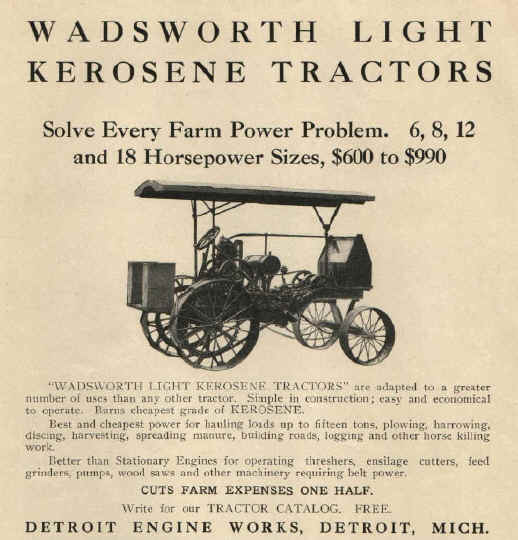

All
literature & photo's copyrighted & protected by worldwide copyright laws.
Research shows that DEW, DMCSC, CEC, DBC, MSBC
were conglomerates
that were owned and operated by the Wadsworth
Manufacturing Co. and
in the later years operated by the Standard
Motor Parts
Co. At this time I do not have any proof that Caille Engine Co.,
Thrall Motor Co., Middleditch Engine Co., Bessemer Engine Co., American Engine Co., Arthur
Colton Co., Petoskey Iron Works or any other engine company was part of this particular
Detroit conglomerate. Although it is very possible that designs, parts,
castings, etc.. were being sold or traded between the companies.
Addresses & information found on original literature.
Detroit
Engine
Works
1236 Jefferson Ave. Detroit, Michigan. (Marine
Advert).
1242 Jefferson Ave. Detroit, Michigan. (Marine
Advert).
1395 Jefferson Ave. Detroit, Michigan. (1905 Marine Advert
Recreation Mag Vol 24 Page 56).
1287 Jefferson Ave. Detroit, Michigan. (1906 Marine Advert
Chautauquan Mag Vol 47).
1251 Jefferson Ave. Detroit, Michigan. (1906 Marine Advert
Pacific Monthly Mag Vol 15).
1263 Jefferson Ave. Detroit, Michigan. (1907 Marine Advert).
1375 Jefferson Ave. Detroit, Michigan. (1907 Marine Advert).
1271 Jefferson Ave. Detroit, Michigan. (May 1907 Marine Advert
Pop Mechanics).
1263 Jefferson Ave. Detroit, Michigan. (1908 Marine Advert
Sports & Recreation Mag Vol 4 Page 70).
171 Bellevue Ave. Detroit, Michigan. (1909 Advert).
1271 Jefferson Ave. Detroit, Michigan. (March 1909 Marine Advert
Pop Mechanics).
1314 Jefferson Ave. Detroit, Michigan. (1909 Marine Engine Advert
McBride's Magazine).
24 Beaufait Ave. Detroit, Michigan. (Jan 1911 Marine Reverse Gear
Advert Pop Mechanics).
40 Meldrum Ave. Detroit, Michigan. (Jan
1911 Marine
Advert).
373 Bellevue Ave. Detroit, Michigan. (1911 Stationary
Engine Advert Bee Culture Mag).
115 Bellevue Ave. Detroit, Michigan. (1911 Advert).
213 Bellevue Ave. Detroit, Michigan. (1910 Stationary Engine
Advert Pop Mechanics Vol 14 Page 132).
213 Bellevue Ave. Detroit, Michigan. (1911 Advert).
1271 Jefferson Ave. Detroit, Michigan. (May
1911 Marine
Advert).
1250-1280 Jefferson Ave Detroit, Michigan. (1911 Advert).
1319 Jefferson Ave. Detroit, Michigan. (1912 Marine Engine Advert
Scribners Mag Vol 51).
116 Concord Ave. Detroit, Michigan. (August 1913 Stationary Engine
Advert Farm Journal Vol 37 Page 454).
1256-1500 Jefferson Ave. Detroit, Michigan. (Jan 02,1913
Letter).
1036 Jefferson Ave. Detroit, Michigan. (Oct 1913 Tractor Advert
Farm Journal Vol 37 Page 550).
187 Bellevue Ave. Detroit, Michigan. (1913 Advert).
361 Bellevue Ave. Detroit, Michigan. (1913 Advert).
271 Bellevue Ave. Detroit, Michigan. (March 1914 Stationary
Advert New England Mag Vol 51 Page 247).
66 Bellevue Ave. Detroit, Michigan. (April 15, 1915).
373 Bellevue Ave. Detroit, Michigan. (March 15, 1915 Stationary
Engine Advert).
1415 Jefferson Ave. Detroit, Michigan. (April 15, 1915 Marine
Advert).
1250 Jefferson Ave. Detroit, Michigan. (1915 Phone book).
24 Bellevue Ave Detroit, Michigan. (Marine Advert).
115 Bellevue Ave. Detroit, Michigan. (Dec 12, 1916).
420 Bellevue Ave. Detroit, Michigan. (1916
Advert).
445 Bellevue Ave. Detroit, Michigan. (1916 Advert).
Corner of Jefferson & Bellevue Ave Detroit, Michigan. (Advert).
Kercheval & Conners Creek Detroit, Michigan. (1918 Phone book).
1723 Jefferson Ave. Detroit, Michigan. (1920 Rudder Marine
Directory Trade List of Ship building).
94 Hatton Garden, London, E.C. England. Head Office and Works Detroit,
Michigan, USA. (Brass Engine Tag).
-------------------------------------------------------------------------------------------------------------------------------------------
DEW (Gear Dept) Manager Feb-08, 1910 J. B.
Dovocau.
DEW Sales Manager Jan-28, 1911, H. M. Fletcher.
DEW General Sales Manager Oct-27, 1911, E. J.
Ellis.
DEW Sales Manager Jan-02, 1912, H. M. Fletcher.
DEW (Marine Dept) Sales Manager 1913, E.
H. Marlow.
DEW General Sales Manager Jan-07, 1916, Fred
W. Elliot.
DEW General Sales Manager Feb-17, 1916, Fred W.
Elliot.
Wadsworth
Manufacturing
Co.
280-284 Jefferson
Ave Detroit, Michigan. (1903 Advert).
1256 Jefferson Ave Detroit, Michigan. (1903 Advert).
1252-1270 Jefferson Ave Detroit, Michigan. (1905 Advert).
1526 Jefferson Ave Detroit, Michigan. (1915 Advert).
1245 Jefferson Ave Detroit, Michigan. (1915 Auto Advert).
1256 Jefferson Ave Detroit, Michigan. (Auto bodies) (1915 Phone
book).
1267 Jefferson Ave Detroit, Michigan. (June 15, 1916 Auto Advert).
Jefferson & Conners Creek Detroit, Michigan. (Factory) (1915
Phone book).
Kercheval & Conners Creek Detroit, Michigan. (1918
Phone book).
Detroit
Motor
Car
Supply
Co.
(Sandow).
Corner of Bellevue & Iron Street Detroit, Michigan. (Advert).
2 Canton Ave, Detroit, Michigan. (May 1910
Sandow Stationary Advert
Vol 14 Page 131).
Bellevue & Iron Streets Detroit, Michigan. (March-25-1911 letter).
2 Canton Ave, Detroit, Michigan. (May 1911 Advert).
2 Mt. Elliott St., Detroit, Michigan. (Jan 1911 Pop Mechanics Marine
Engine Advert).
1258 Jefferson Ave Detroit, Michigan. (Dec-02-1912 letter).
1258 Jefferson Ave Detroit, Michigan. (Dec-14-1912 letter).
1258 Jefferson Ave Detroit, Michigan. (Dec-23-1912 letter).
1258 Jefferson Ave Detroit, Michigan. (Dec-30-1912 letter).
70 Canton Ave, Detroit, Michigan. (1912 Advert).
1258 Jefferson Ave Detroit, Michigan. (Jan-13-1913
Envelope).
88 Canton Ave, Detroit, Michigan. (1913 Advert).
4 Canton Ave, Detroit, Michigan. (April 1915 Advert
Hunter-Trader-Trapper, Sandow Stationary Engine).
1250 Jefferson Ave Detroit, Michigan. (1915 Phone book).
72 Helen Ave, Detroit, Michigan. (1915 Advert, American Exporter Vol 77,
pg 8).
136 Canton Ave, Detroit, Michigan. (1916 Advert).
Kercheval & Conners Creek Detroit, Michigan. (1918 Phone book).
5 Helen Ave, Detroit, Michigan. (Marine Advert).
-------------------------------------------------------------------------------------
DMCSC Sales Manager Dec-02-1912, John
S. hoadley.
DMCSC Sales Manager Oct-21-1913, John
S. hoadley.
Columbia
Engine
Co.
5 MT. Elliott
Ave. Detroit, Michigan. (July 1912 Pop Mechanics advert).
17 Fuller St. Detroit, Michigan. (Dec 1911 Stationary Engine Adv ert Pop Mechanics).
Jefferson & Bellevue Avenues Detroit, Michigan.(August 1911 Marine Advert).
Jefferson Ave. East at Bellevue, Detroit, Michigan. (Feb 24, 1912 Letter).
1273-1285 Jefferson Ave. East Detroit, Michigan. (Feb 24, 1912 Letter).
Holborn, London, E. C. England. (Feb 24, 1912 Letter).
547 Bellevue Ave Detroit, Michigan. (Oct-1915 Pop-Mechanics Magazine Advert).
1275 Jefferson Ave. Detroit, Michigan. (1915 Phone Book).
1256 Jefferson Ave Detroit, Michigan. (1918 Phone Book).
330-334 North 1st Street, Minneapolis, Minnesota. (Gas Power Mag article
1911).
----------------------------------------------------------------------------------------------------
CEC General Sales Manager Feb-24-1912, E.
J. Ellis.
Michigan
Steel Boat
Co.
102 Mill St. Kalamazoo, Michigan. (Jan-June 1901 Advert, Recreation Magazine Vol-14).
280-284 Jefferson Ave, Detroit, Michigan. (1903 Advert).
1252-1270 Jefferson Ave Detroit, Michigan. (1905 Advert).
1300 Jefferson Ave Detroit, Michigan. (1906 Advert).
1334 Jefferson Ave Detroit, Michigan. (1908 Advert).
1252 Jefferson Ave Detroit, Michigan. (1909 Advert).
156 Bellevue Ave Detroit, Michigan. (May 1911 Rowboat Advert).
1271 Jefferson Ave Detroit, Michigan. (1911 Advert).
1273 Jefferson Ave Detroit, Michigan. (1911 Advert).
1347 Jefferson Ave Detroit, Michigan. (1913 Advert).
1250 Jefferson Ave Detroit, Michigan. (1915 Phone book).
1401 Jefferson Ave Detroit, Michigan. (19?? R.G.Dun's Review).
1415 Jefferson Ave Detroit, Michigan. (1905 Advert).
Kercheval & Conners Creek Detroit, Michigan. (1918 Phone book).
Dubois & Guoin Detroit, Michigan. (1918 Phone book).
Corner of Kercheval Ave & Conner Creek Detroit, Michigan. (1919 Advert).
Detroit
Boat
Co.
9 Bellevue Ave
Detroit,
Michigan. (1907 Speed Powered Canoe Advert).
26 Bellevue Ave
Detroit,
Michigan. (1907 Speed Powered Canoe Advert).
1252 Jefferson Ave Detroit,
Michigan. (1909 Advert).
156 Bellevue Ave Detroit,
Michigan. (May 1911 Canoe Advert).
1100 Jefferson Ave Detroit,
Michigan. (May 1911 Advert).
72 Bellevue Ave Detroit,
Michigan. (1912 Canoe Advert).
1122 Jefferson Ave Detroit,
Michigan. (1912Advert).
1151 Jefferson Ave Detroit,
Michigan. (1912 Advert).
1154 Jefferson Ave Detroit,
Michigan. (1912 Advert).
1117 Jefferson Ave Detroit, Michigan. (1915 Advert).
1250 Jefferson Ave Detroit, Michigan. (1915 Phone Book).
1147 Jefferson Ave Detroit,
Michigan. (Jan-1915 Blue Bird Advert).
Kercheval & Conners Creek Detroit, Michigan. (1918
Phone book).
------------------------------------------------------------------------------------
DBC general sales manager, March-15-1912, M.
A. Randall.
DBC general sales manager, 1911, M.
H. Rockwell.
Standard
Motor
Parts
Co.
584-590 Franklin
Street Detroit, Michigan. (Advert)
584-590 Franklin
Street Detroit, Michigan.
(1915 Phone book).
584-590 Franklin
Street Detroit, Michigan.
(1918 Phone book).
United
States
Tire
Co.
245 Jefferson Ave, Detroit,
Michigan. (1915 Phone book).
245 Jefferson Ave, Detroit,
Michigan. (1918 Phone book).
Caille
Perfection
Motor
Co.
1334 Second Ave Detroit,
Michigan. (Advert)
1338 Second Ave Detroit,
Michigan. (Advert)
1213 Caille Street Detroit, Michigan. (Advert)
102 Caille Street Detroit Michigan. (Advert)
Middleditch Engine
Co.
105 Meldrum Ave. Detroit, Michigan. (Dec 1911 Engine Advert Pop
Mechanics).
_______________________________________________________________________________
The sketch below is of the DEW Factory's on Jefferson Ave Detroit,
Michigan. which
included WMC, DBC, MSBC and CEC. In this sketch DEW manufacturing facilities
appear to be very large. One of the
DEW
advertisements stated their factories cover eight acres of land another
later ad claims fourteen acres. It is not known just how accurate
the pictures below are. Artist sometimes exaggerate
these pictures for advertising. The street below with the rail car
tracks in the middle is Jefferson Ave. in the background you can see the
Detroit River. Building on the far left is the same building shown in the
picture below this one.
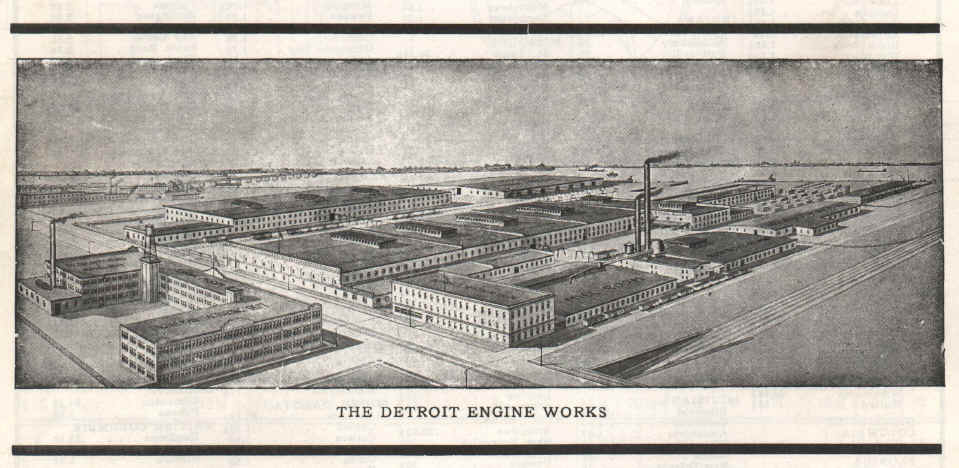
The
factory below was built around the 1905 time period and located at
the corner of 1256 East Jefferson Ave. & Bellevue Ave. on the north side
of the street. New address 6601 East Jefferson Ave. (Addresses were re-numbered in 1921).
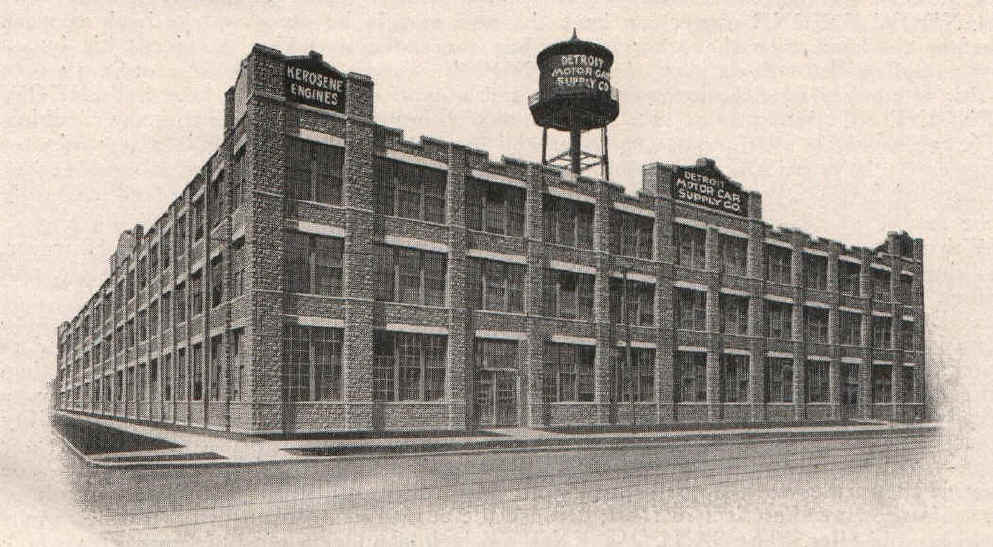
All
literature & photo's copyrighted & protected by worldwide copyright laws.
ABBREVIATIONS
DEW
=
Detroit
Engine
Works.
WMC =
Wadsworth
Manufacturing
Co. DMCSC =
Detroit
Motor
Car
Supply
Co.
CEC =
Columbia
Engine
Co.
MSBC =
Michigan Steel
Boat
Co.
DBC =
Detroit
Boat
Co. SMPC =
Standard
Motor
Parts
Co.
CPMC =
Caille
Perfection
Motor
Co.
MEC =
Middleditch Engine
Co.
BGEC =
Bessemer
Gas Engine
Co.
TMC =
Thrall
Motor
Co. T&MC
= Termaat
& Monahan Co.
AEC = American
Engine Co. PIW
= Petoskey
Iron Works. Updated
03-05- 2019
Principals of the DEW in 1903 were Hugo Scherer as president and Frederick E. Wadsworth as secretary and treasurer.
In 1911 Hugo Scherer was president of the firm with Frederick E. Wadsworth as secretary and treasurer. Scherer and Wadsworth also owned and managed the
DMCS, TMC, and CEC.
Both Scherer and Wadsworth were also the principals of the DBC which was located at the same facility and manufactured launches and canoes.
Detroit Engine Works, Detroit Motor Car Supply Co.,
Columbia Engine Co.,
Michigan Steel Boat Co., Detroit Boat Co., Caille Perfection Motor
Co., Middleditch Engine Co. and Bessemer
two cycle engines are all pretty similar.
All of the companies were located in Detroit, Michigan with exception of
Bessemer who bought out Middleditch Engine Co.
Below are a few photos of the engine tags that were used on Detroit
Engine Works engines and a few other similar engines.
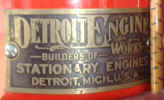 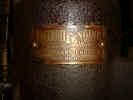  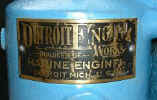  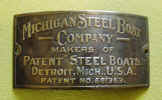
 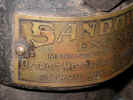
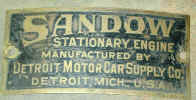
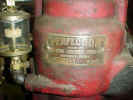


An original Columbia marine engine catalog illustrating their line of
engines actually shows two or three pictures of their engines with
Detroit Engine Works name tags attached to the cylinder. Original
literature clearly illustrates that Detroit Engine Works manufactured
two cycle engines for Columbia Engine Company, Detroit Motor Car Supply
Company, Michigan Steel Boat Company and Detroit Boat Company.
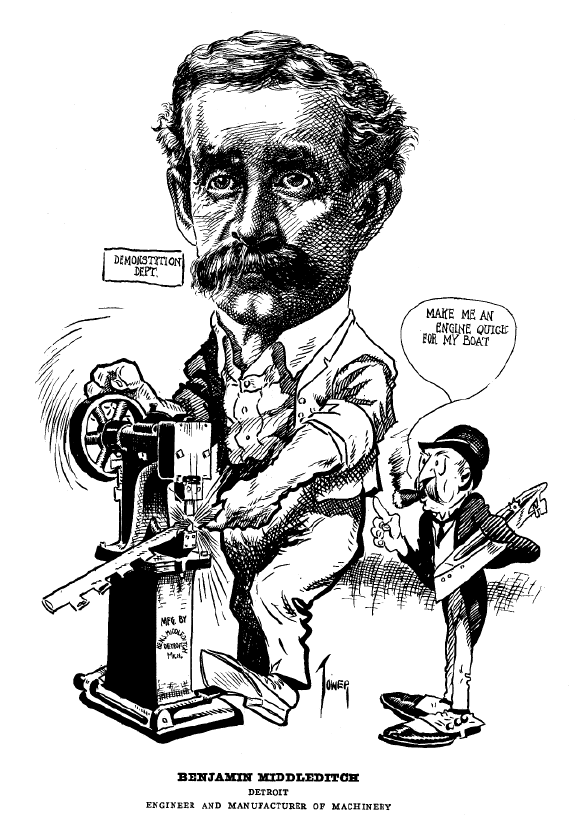 |
It is said that Benjamin J. Middleditch designed the two cycle explosion engine with its fuel
injection system that made Detroit Engine Works and its related
companies so popular back in the early 1900's. As of May 26,
2006 research has been done on patents listed under the Middleditch
name from 1879 through 1925 and only
one patent has been found (0577,739) issued to Benjamin J. Middleditch and Edward J. Frost
and it is a device for regulating the quality of gas. This patent is for
a fuel & air mixing chamber/reservoir which includes a float, ball
& needle that regulates the amount of fuel and air allowed in
the chamber while always maintaining the same quality of fuel &
vapors going out of the chamber. This device appears to be almost the same
design mixing chamber that is being used on many of the Detroit engines
equiped with low pressure fuel injection systems, Peterson, DEW,
DMCSC, Colton, Columbia, CPMC, MEC,
BEC. While there has been no proof or patent found that shows
Ben Middleditch designed this two cycle explosion engine and its
fuel injection system. He was involved in the design of the mixing chamber/reservoir for the fuel injection system.
He also manufactured some of the first fuel injection systems
for the Detroit made engines.
December 05, 2006, Through research I have discovered that there is a very good possibility
that Ben. J. Middleditch either owned or had a license for the patent writes to patent # (840,178)
for
the universal fuel feeder that Middleditch Engine Co. and Bessemer
Engine Co. used on their two stroke engines. The patent was originally
submitted May 25, 1905 by Daniel M. Tuttle and patented on January 1st 1907.
Photos of a early model
Bessemer two cycle engine have surfaced with embossed patent dates. See
1915 infringement lawsuit below for the whole story.
|
Benjamin Middleditch was born
in 1859 in Amherstburg, Ontario Canada. Ben and his British born wife,
Lucy H. Middleditch moved to Detroit in 1880 and started their own
general machine shop business. Ben Middleditch became very popular in Detroit as a engineer and manufacturer of
machinery and engines. He also bought and sold real
estate on the side and made a substantial sum of money doing so.
Ben and Lucy Middleditch had two son's who were well educated with college
degrees and also attended the military.
Lieutenant George O. Middleditch born in Detroit, Michigan on
November 20, 1894. George was a pilot for the Royal Flying Corps
44th training Squadron. One day while testing a new plane something went
wrong and the plane did a nose dive and crashed. Lieutenant
George
O. Middleditch died on March 12, 1918. The second son, Leigh B.
Middleditch was a second Lieutenant in the field Artillery and was killed
in a air battle over the trenches in France.
Phillip Middleditch (Older brother of Benjamin
Middleditch) was born in Amherstburg, Canada in 1856. Phillip was the
proprietor of a company Petoskey
Iron Works
located at 315 State Street Petoskey, Michigan. City directories show
PIW in the Petoskey area around the 1906-1910 time period. PIW's sold
marine engines that looked very close to the marine engines that Detroit
Engine Works produced. Benjamin Middleditch helped his older brother
design and manufacture the company's first engines. This was a very
small company that was only in business for a few years. PIW was
also a sales agent for the Alamo Engine Co. The Petoskey Iron Works
business was sold around the 1911 time period and the manufacturing of
the Petoskey two cycle marine engines ceased. New owners continued in
business as a repair shop and agent for Alamo engines. Phillip
Middleditch died in 1914.
By 1910 Benjamin Middleditch was manufacturing and selling his
own design stationary and marine two cycle engines that looked very similar
in design to the DEW engines. The engines brass tag was
embossed with the Middleditch
Engine
Company name.
MEC only manufactured these two cycle stationary & marine engines for a few years. In 1913
Bessemer
Gas Engine
Co. purchased the
Middleditch Engine Co. of Detroit Michigan including its stock of
engines, patterns, jigs, and patents. BGEC continued producing the
two cycle engines with their own brass Bessemer Engine Co. name tags into
the 1920's. BGEC also designed and manufactured a hopper cooled and air
cooled version of the stationary style engines. Benjamin J. Middleditch died May 22, 1916 at the age of 57.
Patent # 926,892 shows that John Peterson & Frederick O. Peterson designed the
two cycle explosion engine with its fuel
injection system. Although their patent was applied for on February 24, 1908 and
patent issued on July 06, 1909 we know that their design and engine was
already being produced by DEW at least a couple of
years before the patents were issued. There is a original DEW
catalog with a 1907 date showing the two cycle explosion engine with its
fuel injection system. It is not known if John Peterson and Frederick O.
Peterson were assignors to DEW or MEC. Ben J. Middleditch manufactured this fuel
injection system for DEW. DEW
also manufactured two
cycle marine engines with a regular float type carburetors and mixer
type carburetors before and
after the fuel injection system was manufactured.
DEW engineers eventually designed and
manufactured their own fuel injection
system. The one piece fuel feeder-Injector patent was applied for on
January 7, 1911 was designed by Frederick Barthel. Patented May 14, 1912 (patent #1,026,425).
Frederick Barthel, born: 1866, Died: 1922, Grave: Forest Lawn
Cemetery Detroit, Wayne county, Michigan. Wife: Ida
Bowman.
There were three styles of this one piece fuel feeder/Injector produced.
See Identifying engines & parts section on the main menu for photos
& info on the three different
styles.
Source:
Steam Magazine Volume 11 & 12
January 1913.
Patents:
University of Central Florida Library.
1915 Lawsuit
The information in the paragraphs
below were found in a 1915 original Bessemer two cycle engine catalog.
I thought
that this information might be of interest to other engine collectors.
In a description of the Bessemer Universal Fuel Feeder this is what was
found.
"“We own the original basic patents on this fuel feeder, and if any one else, either in a catalog, in a letter or personally
attempts to make you believe otherwise, you can put them down immediately as impostors who, if they will deceive you on such
an important matter as this would not hesitate to deceive in any way necessary to gain their purpose."”
"“At the present time there are two other engine manufacturers using devices which are clearly infringements of our Universal
Fuel Feeder."”
"“We are now prosecuting the larger of these two concerns for infringement and as soon as this case is over we will take up
the other, and in every case where we find it necessary we will defend our rights and property and that of our customers,
to the full extent of the law."”
"We have no intention
whatever of taking recourse against the innocent purchasers of these
infringements and consequently we do not issue the usual
"warning" to that effect, but when considering the purchase of
an engine it might be well to take the fact into consideration that, if
possible, We intend to stop any and all infringements of our rights, and
that if you buy an engine that is clearly such and we shortly thereafter
stop the manufacture of it by law, the guilty firm would undoubtedly go
out of business altogether or else take up the manufacture of a new type
engine, in which case you would be forever unable to secure repairs for
your engine in case of accident."
"This device is one of the
many things which puts the Bessemer Kerosene Engine in the lead, makes
it a more expensive engine to build and consequently renders it
impossible for us to compete with the cheap four cycle gasoline engines
which are being turned out by the million and are made only to
sell."
I first read about this
infringement of the Bessemer Universal fuel feeder a few years back when
I was on a antique engine forum on the internet. A gentlemen named Arnie
Fero from Pittsburg PA had posted the information and said it was a quote
out of Bessemer two cycle engine catalog he had. I really wanted
to get a copy of this Bessemer catalog and see if there was any more
information on this subject and try to figure out who it was that was
infringing on their patents. I knew that it probably involved Detroit
Engine Works. The problem was Arnie's information had been posted
in March of 2001 and I was now reading it in 2004. Another year
went by and one night I was bidding on a Bessemer engine catalog on Ebay
through the internet. I won the bid and just a few minutes or so after
the auction I received a email from a fellow engine collector who was
also bidding on the catalog but had lost the bid and wanted to know if
it would be possible if he could purchase a copy of the catalog. I
noticed his name was Arnie Fero, so ask if he was the gentlemen that
posted the Bessemer fuel feeder infringement information on the antique
engine forum a few years back. He indeed was the same gentlemen. So we
worked up a trade and sent each other copies of our catalogs. I never
did find any more information about this fuel feeder infringement until
one day in 2006 I was going through some old digital photos I had
collected over the years and I found a few photos of a very early
Bessemer two stroke engine, one photo was a close up of some embossing on the engine
inspection plate (The Bessemer, Grove City, PA). Another photo of the
crank case showed embossed (Patended, January 1st 1907). After seeing the photos I thought
this might be the answer I have been looking for. I went to the US
patent website and searched through patents until I narrowed down where
the January 1st 1907 patents started and ended. This took a little time
and once I got this info there were still thousands of patents to be
searched. So I got a friend of mine to help me
search. After about a week or so we finished looking through all the
patents for January 1st 1907 and found only one engine patent, #
(840,178) by Daniel M. Tuttle, for January 1st 1907 and it did not look
exactly like a Bessemer or Middleditch two stroke engine to me. I lost interest
after this because I could not figure out what was going on. Why
couldn't I find this patent? About six months later I was looking
through some of my old literature and paper work and I come across a
copy of this same patent that I printed out back when we originally
found it. I looked at the patent again and this time I read all the
pages and looked over the drawing closer. This was the same basic fuel
injection design being used it was just drawn a little different. I knew that this was indeed the patent that Bessemer sold
their engines under and probably the original patent for the low pressure fuel
feeder for which the rights were originally owned by Daniel M. Tuttle.
It appears that Ben. J. Middleditch may have acquired the rights to this
patent at
some point. I have no hard evidence of this but the fact remains
that the design of this low pressure fuel injected engine seem to follow
Ben J. Middleditch from factory to factory no matter what company he
worked for.
Daniel
M.Tuttle, Middleditch, Bessemer fuel feeder patent # (840,178) January 01,
1907.
John
Peterson & Frederick O. Peterson, DEW fuel feeder
patent # (926,892) July 06, 1909.
Frederick
Barthel, DEW second fuel feeder patent #
(1,026,425) May 14, 1912.
The two later patents above
are very similar to the same basic original patent with improvements being made with each
design. This is probably where the infringement problems came to
play. DEW and DMCS could have been the two companies BGEC were talking about infringing on
their patents
---------------------------------------------------------------------------------------------------------------------------------------------------------  June 16, 2011
June 16, 2011
Source: Iron Age Magazine Volume 90 page 1149,
November 14, 1912.
"The Bessemer Gas Engine Company, Grove City, Pa. has purchased the gas
engine business of the Middleditch Engine Company, Detroit, Michigan,
including its stock of engines, patterns, jigs and patents. In addition
it has bought the patents of John Peterson and Frederick O. Peterson,
covering the Universal fuel feed, which enables small engines to operate
successfully on kerosene, naptha and low grade distillates. The Bessemer
gas Engine Company has felt the need for some time of a line of small
engines to make its line more complete, and this purchase gives it a
full range of gas engines from 2 to 350 hp."
Detroit Engine works and its related engine
companies were still manufacturing engines and fuel feeders under
Frederick Barthel's patent # 1,026,425 up until about the 1919 time
period. This may have been why the law suit was filed by Bessemer.
----------------------------------------------------------------------------------------------------------------------------------------------------------
Source:
American Gas Engines since 1872 (C.H.Wendal)
1912,1913,1915 original Detroit Engine Works letterheads.
Patents:
University of Central Florida Library.
Original company literature 1907 through 1917.
1915 original Bessemer engine catalog.
(Donated
by Arnie Fero).
US Patent
Office website.
University Of Central Florida computer patent search program and microfiche.
Research done by:
(John
C. Davis), Davis Antiques & Scale
Models.
Wadsworth builds "Flying
Fish" Hydro-Aeroplane.
In 1911 Wadsworth, built a Hydro-Aeroplane
named the Flying Fish which debuted at the New York Boat Show. The unusual
vehicle was designed to skim on top of the water at speeds up to 65mph,
with the ‘skipper-pilot’ seated in a wicker chair at the rear of its
canoe-like hull. The Flying Fish was successfully tested on the ice of
Lake St. Clair but no further development occurred.
Detroit Stove Works.
The Detroit Stove Works was located one block to
the east at 1320-1360 E. Jefferson Ave. and in late 1909 the Hupp Motor
Car Co. moved into a new facility built on the former Olds grounds at
1300-1320 E Jefferson Ave. (at Concord). When Hupp relocated to larger
facilities at Milwaukee and Mt. Elliott Aves in 1912, the King Motor Car
Co took over Hupp’s Jefferson Ave factory.
Located to the west of the Wadsworth factory at 1210 E Jefferson Ave.,
was the national headquarters of the Stove Mounters Union of North
America. During the late 19th century Detroit was the stove
manufacturing capital of the US and three of the nations largest
manufacturers; the Detroit Stove Works, Michigan Stove Works and
Peninsular Iron Co. were located along E. Jefferson Ave.
______________________________________________________________________________________________
Detroit Engine Works sells plant to
United States Tire Co. 1915.
By 1915 the firm had grown to include these managers and officers: Hugo Scherer, President; Frederick E. Wadsworth, Secretary and Treasurer; H. E.
Cronenweth, General Manager; W. C. Rowling, Purchasing Agent; and A. M.
Ratigan, Advertising Manager.
Detroit Engine Works sales flyer shown below
states:
“Our plant has been sold to the United States Tire
Co. and our new plant is not yet ready so that we can carry in stock
only a limited amount of engines and machinery for a few months and
rather than pay this storage we are going to sell the majority of our
stock.”
The Original Wadsworth plant at 1252-1270 E
Jefferson was purchased by the United States Rubber Co. (manufactured
the United States Tire), as was the former Hupmobile/King plant at
1300-24 E. Jefferson (at Concord).
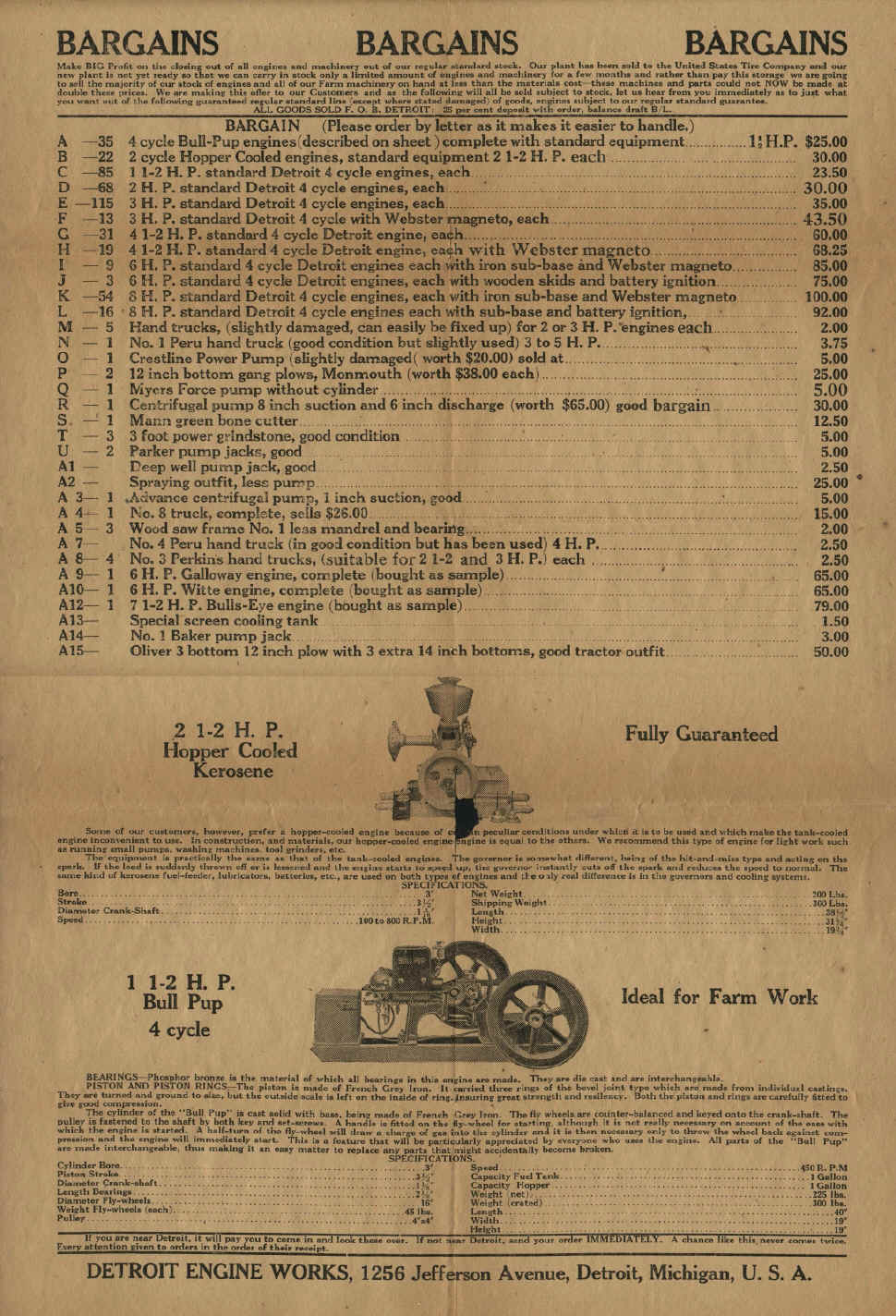
All
literature & photo's copyrighted & protected by worldwide copyright laws.
Originally from
Chicago, the Morgan & Wright Bicycle Tire Co., moved to Detroit
to take advantage of its burgeoning automobile industry. Its
first
Detroit
plant was erected on a portion of the former Old Motor Works parcel, east of
the
Wadsworth
plant. Completed in October of 1906, several of
Detroit’s Automobile Shows were held inside the 900,000
sq ft complex. Wadsworth
Manufacturing Co.'s
New Factory built 1915.
Morgan & Wright was purchased by the United
States Rubber Company in 1914. US Rubber wished to expand the existing
plant and made a generous offer for the original Wadsworth Manufacturing
Co. complex. With the proceeds Scherer and
Wadsworth
purchased a large undeveloped plot on
Jefferson Ave. 3 miles east of the current facility in the area known as Conners
Creek. The Sibley Lumber Company and the Inside Inn Hotel was located
just across the street. Detroit Engine Works, Detroit Motor Car Supply Co.,
Columbia Engine Co. were still manufacturing engines at this time and
Michigan Steel Boat Co., Detroit Boat Co. also continued to manufacture
boats.
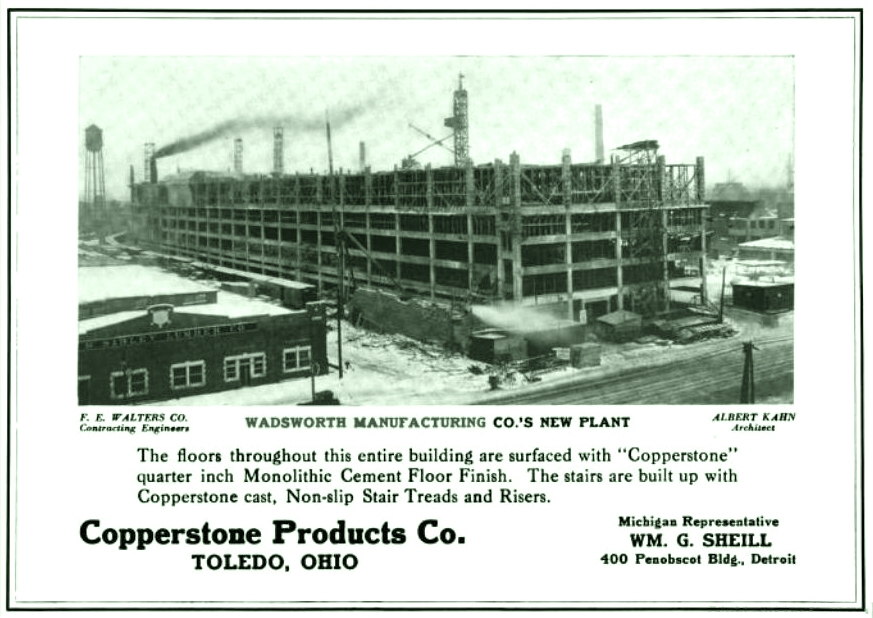
All
literature & photo's copyrighted & protected by worldwide copyright laws.
Located on the north side of East Jefferson Ave.
and Conners Street the new facility featured a railroad siding connected to the Detroit
Terminal Railway, which gave them direct access to Ford Motor Co.’s
Highland Park
and River Rouge assembly plants. Plans were drawn up by Detroit
architect Albert Kahn and construction of the new modern facility -
which was bordered by Kercheval Street
to the north and Corey Place
to the west - commenced in 1915. The new factory had 700,000 square feet
of floor space. In June of that year the firm reported
that they had spent $30,000 on new construction at the Conners Creek
factory.
The photo above shows the Wadsworth Mfg Co.'s new six story
factory as it was being built in 1915. The new address as listed today
would be 12262 Kercheval Street Detroit, Michigan. This is the same
basic location as the Kercheval Chrysler plant.
June 10th, 1915 issue of the Iron Age magazine reported
that Frederick E. Wadsworth, secretary and treasure of the Michigan
Steel Boat Company, the Detroit Engine Works and Detroit Motor Car
Supply Company, has purchased property 300 x 1200 ft, in the Fairview
factory district, Grand Rapids, Michigan as the site for a new factory.
It is understood that the construction of a four-story factory 240 x 260
ft, will be started at once. The building is to be used by a new company
in the manufacture of motor car bodies.
It is not known if this factory was ever built in the Grand Rapids area.
No information or addresses have surfaced at this time.
By late 1918 Wadsworth’s new Conners Creek plant was running at full capacity. With an
authorized capitalization of $1,000,000 the company’s officers at the
time were as follows: Frederick E. Wadsworth, president; Henry E. Bodman,
vice president; Herbert E. Cronenweth, secretary and treasurer. The
firms various activities were listed in the Chilton Directory as
follows:
“Wadsworth
Manufacturing Company,
Kercheval avenue
and Connor's Creek,
Detroit,
Mich.
Sedan
and closed automobile bodies, automobile parts; automobile painting and
trimming. Cable address, "Motorcar,"
Detroit
.”
A May 17th 1918 inspection of the Wadsworth
plant by the State of Michigan Dept of Labor gave the following
statistics.
Wadsworth
employed a total of 1,125 persons of which 951 were male, 174 female,
and 4 were under the age of 16.
Wadsworth’s new Vice-president, Henry E. Bodman, was closely associated with
both Packard and Ford and it is believed he represented the automakers
interest who at that time owned a substantial portion of Wadsworth
Manufacturing’s stock.
Henry E. Bodman was born in
Toledo,
Ohio
on Aug. 8, 1874 and admitted to the Michigan
bar in 1897. By 1918 he had become chief attorney for the Packard Motor
Car Co. and would soon become one of the Ford Motor Co.’s lead
attorneys. He later served as Henry and Edsel Ford’s personal attorney
and in 1927 founded the
Detroit
law firm, Bodman LLP, which remains one of Detroit’s largest firms. During World war II Bodman served his country as
chief counsel for the Automotive Council for War Production. Bodman also
served on the board of directors of a number of Detroit-based firms
among them the Guardian Detroit Bank, Provident Loan Co., Detroit City
Gas Co. etc. During the mid-to-late Twenties he served as chairman of
the Guardian Trust Co.
Prior to his marriage to Mannering,
Wadsworth purchased an estate in Irvington on the Hudson river in New York and in 1916
announced that he intended to live in New York permanently and was putting
his Grosse Pointe estate on the market.
Scherer remained friends with Frederick E.
Wadsworth and continued to operate H. Scherer & Co., Detroit Forging
and St. Clair-Athol Rubber from his offices at 280-274 E Jefferson.
Shortly before his death Scherer stated he had decided to retire from
active business and place the affairs of H. Scherer & Co. in the
hands of his trusted staff, which included Clemons H. Davis (Manager),
Hugo Miller (Secretary-Treasurer), and Lovell E. Kraus. All three men
hade been led by Scherer to believe that they would be compensated
beyond their salary if they remained with the company after Scherer’s
retirement.
Unfortunately, those wishes were not noted in his will and when Scherer
passed away in November, 1923, the firm passed to his wife - Clara
Schmidt Scherer – and two daughters, Marion Scherer Livingstone &
Dorothy Scherer Higbie.
Consequently Davis, Miller and Kraus sued the estate and after a 4-month
long court battle the firm of Davis, Kraus & Miller was formed and
the assets of H. Scherer & Co. were transferred to the new
corporation in exchange for all of its stock consisting of $250,000 of
preferred which was issued to Scherer’s widow and two daughters, and
$250,000 of common, which was issued to Davis, Miller and Kraus.
Davis, Kraus & Miller relocated into leased quarters at 442 E. Jefferson
and continued to supply Detroit’s auto industry with textiles and trimming materials into the early
thirties.
_______________________________________________________________________________________
Wadsworth Mfg Co. transfers
DEW, DMCSC,DBC,MSBC,CEC
to Standard Motor Parts Co. 1918.
DEW, DMCSC, DBC, CEC & MSBC All were ran as
a side issue by the WMC, Which was primarily
in another line of business. (manufacturers of auto bodies, auto tops and auto
parts). As consequence the service on the repair
parts became badly demoralized, and to protect the engine owners radical
changes had to be made. Wadsworth management decided to transfer these companies to the Standard Motor
Parts Company. It is not known if these companies were sold or if
Standard Motor Parts Co. was just paid to manage them and/or the parts
and service departments. Located at 584-590 Franklin St
,
Detroit, Standard Motor Parts specialized in providing service and spare parts
to owners of bankrupt, orphaned and obsolete automobile, tractor and
small engine manufacturers. Originally located in
Kalamazoo, the firm was founded by Edwin J. Dayton who relocated the firm to Detroit
in the early teens. The firm prospered, eventually establishing service
depots in
Syracuse, New York,
Cleveland, Ohio, Lebanon,
Muncie, Newcastle,
Indiana, Chicago and
Illinois. DEW, DMCSC, DBC, CEC,
MSBC went out of business shortly after the transfer around 1919-1920
time period. This is the same time period that Wadsworth
Manufacturing Co. was succeeded by the
American Motor Body Company. Also in this time period is when the
Wadsworth factory auto workers union went on strike and then the suspicious
fire that totally destroyed the factory.

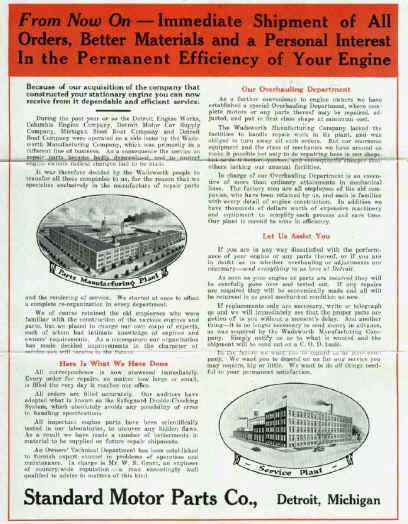
(click to
enlarge)
(click
to enlarge)
All
literature & photo's copyrighted & protected by worldwide copyright laws.

Address & info listed for Standard Motor Parts Co. in the 1918 City
directory, E. J. Dayton, Pres. and Treas.; W. S. Grant, Sec.
Manufactures of Auto Parts at 584-590 Franklin Street Detroit, Michigan. Photo courtsey of Burton Historical
Collection Detroit Public Library. The SMPC headquarters in Detroit was incorperated March 12, 1915
Edward J. Dayton was born in Kalamazoo Michigan August 5, 1887, a son of Edwin Charles and
Mary (Joy) Dayton. In Mr. Daytons early years he worked for a paper mill in
Kalamazoo for 7 years and was identified with that business. Soon after
he became involved with SMPC in Kalamazoo for a time and eventually
moved to Detroit starting his own branch which he owned the controlling
interest and has since been president of the company. From its inception
the undertaking proved a success and as the years have passed it has
developed rapidly until the business assumed extensive
proportions. The Detroit plant is the headquarters of the company, SMPC also maintained service stations and likewise operate branch
establishments at syracuse, New York; Cleveland, Ohio; Lebanon,
Muncie and Newcastle, Indiana; and Chicago, Illinois. Mr. Dayton gives
his close personal attention to the details of the business, the
developement of which is a most excellent tribute to his ability to see
clearly its larger aspects.
Sources:
Original Standard Motor Parts Company, Detroit,
Michigan mail out flyer from 1917 period. (Donated by David
Clark from Missouri Ozarks ).
Info own company management and address for Standard Motor Parts
Co. donated by:
Scott M. Peters, Collections Historian
Michigan Historical Museum.
1918 Detroit City Directory, published by R. L. Polk & Company page
1647.
www.1847usa.com
(US Stamps) used to date Standard Motor Parts Co. flyer.
____________________________________________________________________________________
Letter from Ford Motor Co.
A letter from the Ford Motor Co. archives, General
Letter No. 347 dated Feb 20, 1919, mentions problems associated with
Wadsworth’s sedan bodies:
”FROM: Ford Motor Company, Detroit Office
February 20, 1919
General Letter No. 347
INSTRUMENT BOARD
”One length of board is being furnished for sedans, both
Wadsworth and Fisher made, and as the Wadsworth body is somewhat wider
between pillars at instrument board section than the Fisher body, it
becomes necessary for various reasons that one length be furnished for
both jobs and when branch receives same it will be in order to cut off
ends of the board to fit Fisher body if Fisher bodies are being
received. After cutting the boards to size, see that the imitation
leather is again placed over ends of boards in a workmanlike manner.
Instruments will be shipped to branch from main plant with instrument
boards until the body manufacturers can bring the instrument boards
through to fit their respective bodies, after which they will ship
bodies with the instruments and wiring fastened thereto so that same can
be fastened to dash assembly in accordance with diagrams which you have
at this time. Coupe bodies are now going forward with the instrument
board in position.”
________________________________________________________________________________________
The June 23, 1910 issue of the Automobile reported:
Detroit June 2, 1910 – Two new automobile companies have been
formed here during the past week. They are the Hupp-Yeates Electric car
Company, $100,000 capital, which will build a new type electric and a
concern headed by Hugo Scherer and F.E. Wadsworth of Michigan Steel Boat
Company which will have a capitalization of $250,000 and which will build
a small car of more horsepower, about 100-inch wheelbase, to weigh under
1,900 lbs. This car will sell for under $1,000.
The partner’s car was to be called the Tom
Thumb, and was named after Peter Cooper’s diminutive steam locomotive
that ushered in the railroad age in 1830. Another news item relating to
the Tom Thumb followed:
This building at the corner of Bellevue street, is for Hugo Scherer and F.E. Wadsworth, who have formed a new company to
build a low-priced car.
However, there is no evidence the vehicle
ever made it past the prototype stage, and even the existence of a
prototype is doubted.
_________________________________________________________
Frederick E. Wadsworth was a founding member
of the Detroit Aero Club, and created a small scandal in 1911 when he
divorced his current wife and married a famous British actress.
The actress, Mary Mannering (b.1876 d.1953)
was born in London where she studied for the stage under Hermann Vezin.
She made her debut at Manchester in 1892 under her own name of Florence
Friend. In 1896 New York theatrical producer Daniel Frohman brought her to
New York where she changed her name to Mary Mannering, the maiden name of
her father's mother. Her first star billing came at Buffalo, NY in 1900
when she appeared in ‘Janice Meredith’ in the title role. For the next
ten years she starred in various productions; White Roses (New York,
1901); The Truants (Washington, 1909); The Independent Miss Gower
(Chicago, 1909); A Man's World and The Garden of Allah (New York, 1910).
After her 1911 marriage to Wadsworth,
Mannering retired from the stage, and devoted her life to assisting her
husband in civic and business affairs. In 1912 she was credited with
building nineteen cottages for working men and their families on the
former Wadsworth estate in Gross Pointe Farms. By the late teens she was listed as
Vice-president of the Michigan Boat Works. Later in Life she was
interviewed by Good Housekeeping, who published her interview in an
article titled The Home, The Stage and the Woman.
Source:
An Online Encyclopedia of
American Coachbuilders & Coachbuilding.
http://www.coachbuilt.com/bui/w/wadsworth/wadsworth.htm
_______________________________________________________________________________________
Wadsworth
Strike April 18, 1919 & Fire August 1, 1919 cost millions.
Wadsworth
was plagued by a number of strikes initiated by the fledgling United
Automobile, Aircraft & Vehicle Workers Union (UAAVW, predecessor to
the AWU or Auto Workers Union) in April and May of 1919. The initial
strike was covered by the Associated Press who reported the following on
April 18, 1919:
“Will Institute Six Dollar Day Wage In Detroit
Firm
“Detroit, Mich., April- 18.—Six dollars a day minimum wage
and a 47 hour week will be instituted by the Wadsworth Mfg Co. on
Monday, according to Frederick E. Wadsworth, president of the
corporation which make automobile accessories. The company has been in
controversy with some 2,500 of its employees who went on strike
Wednesday and according to labor leaders at the plant this announcement
is the result of the workers' demands for more pay and less work.”
The April strike of some 1,500 workers (the
2,500 quoted in the paper was highly inflated), about 90% of whom were
in the union, was precipitated by the company's desire to dictate who
should be elected to the workers' committees.
Under strict orders from Ford’s
representatives,
Wadsworth
management refused to meet with the committee, and presented the
‘Six-Dollar Wage’ statement to placate the public.
Not only did this strike constrain Ford’s
output during a period of potentially booming sales, but Ford was
worried about the UAAVW getting a foothold in his own plants.
Wadsworth
management brought in idle Ford employees for strike-breakers and
advertised for help all over the country.
Fed up with the labor unions interference,
in mid-July 1919 Henry Ford began installing his own body-building
equipment into Building B of Ford’s Eagle Shipbuilding plant.
Although the local Board of Commerce tried
to assist Wadsworth/Ford in its efforts to break the strike,
negotiations ended when the Wadsworth plant was totally destroyed by a
‘suspicious’ fire on the night of Friday, August 1, 1919.
Fire in Detroit
does over a million in damage.
The International News Service reported: “Detroit,
Michigan, Aug.
2.—Damage estimated at more than $1,000,000 was caused last night when
the Wadsworth Manufacturing plant, in the east end of this city, was
almost entirely destroyed by fire and other business houses slightly
damaged. The fire is thought to have been caused by combustion, and
originated in the paint shop of the Wadsworth
company. The Sibley Lumber company suffered $100,000 loss and the Inside
Inn hotel was totally destroyed.
On Saturday, the Detroit News included a
photo of the fire and the following short article:
“August 02, 1919
Detroit
- Minutes after the first alarm was given, the plant of the Wadsworth
Manufacturing Co. was in flames. The photograph, taken from Jefferson Avenue, shows the extent of the destruction.
The roof caved in quickly, flames reflecting from a background of
dense smoke illuminating the sky. Three explosions helped demolish the
structure and hurled burning timbers to nearby factories which took
fire, among them the Maxwell Chalmers plant. A high wind aided in
spreading the flames. A falling wall struck two fire engines, wrecking
them.”
Copy of news paper photo of
August 02,1919

Wadsworth Mfg Co. located at East Jefferson
Ave. & Kercheval St. (Conner Creek area).
(click to
enlarge)
The two photos below were donated by T.K. Sand, who created a website called (Before
My Time) about the ancestry and extended family of her four
grandparents. Among the photos kept by T.K's grandparents were the two
below. Her grandparents lived in the 1000 block of Jefferson Ave. in
1919. The photos are
believed to be of the Wadsworth factory after the August 01, 1919 fire.
If anyone has information about these photos or the fire please contact
me. mazak@rocketmail.com

(click
to enlarge)

(click
to enlarge)
Below T.K. Sands combined the unidentified photo with
the Detroit News paper clipping
of the actual Wadsworth factory fire so a comparison could be made
between the two buildings.
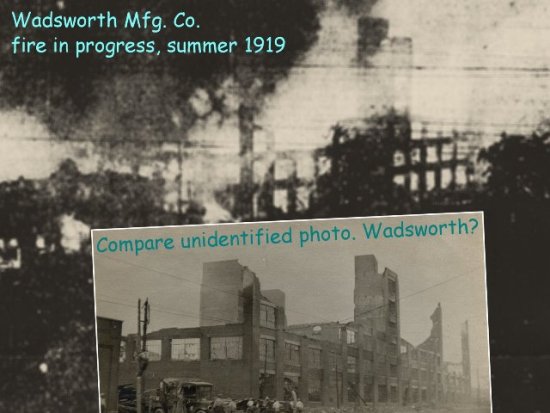
(click
to enlarge)
After the
Wadsworth factory fire a 1919 issue of Safety Engineering Magazine stated that the No. 6 building was 6 stories in
height and divided into 3 sections by 12 inch single fire doors operated
by fusible links. The building was filled with highly flammable contents
and had automatic sprinklers fed from a 50,000 gallon water tank up
above the roof on a tower. The fire occurred on one of the upper floors
and spread through the wall openings in the different sections, the
result being the opening of a large number of sprinklers that without
doubt the water in the sprinkler tank was quickly exhausted, after which
the fire had it's own way, and the final loss was about $1,250.000. The
reason the sprinkler system failed was because the 12 inch fire doors
were not fully automatic and sufficient enough. If these doors had automatically
closed the fire would not have spread so quickly and more
then likely would have allowed the sprinkler system to put out the fire. In
December of that same year (1919) the Wadsworth home at Grosse Pointe
Farms was burned. No information on what caused the fire. The house was
rebuilt and remodeled only to be destroyed again from a fire two years
later (Aug 19, 1921) when the house was struck by lightning during a
thunder storm. House valued at $150,000. The Wadsworth family were at
their summer home in Nantucket Massachusetts each time the two fires occurred.
Source:
Detroit
News paper, Detroit public Library.
Research done by: John
Davis, Davis Antiques & Scale
Models.
T.K. Sand : (Before
My Time) two photos from T.K. Sand grandparents.
1919 Safety Engineering Magazine.
By early 1920,
Wadsworth
had rebuilt the factory and sedan bodies were once again being shipped
to Ford. However, Ford had contracted with other firms during the
lengthy fire-induced shutdown, so the unwelcome additional capacity was
used to construct production bodies for other Detroit
manufacturers such as Gray, Hudson, Maxwell and Chalmers.
Although the firm had transferred its marine, stationary farm engine and
parts service to Standard Motor Parts Co., Michigan Steel Boat Company
continued to be listed in the Detroit
directories at the Corner of Kercheval Ave & Conner Creek, the same
locations as Wadsworth Manufacturing. At that time Michigan Steel
Boat’s officers were as follows: Frederick E. Wadsworth, president;
Mary M. Wadsworth, vice-president; H.E. Cronenweth, treasurer.
For
many years Herbert E. Cronenweth, (b.1884) was associated with the
management of Scherer and Wadsworth’s various enterprises. When Wadsworth Manufacturing was dissolved in
1920, Cronenweth headed to Los Angeles
where he became involved in the oil and real estate business heading the
Acme Petroleum, L-Her Oil and Land, and L-Her Realty Co.
American Motor Body Co. purchases
Wadsworth Mfg Co. Nov of 1920.
American Motor Body Co. had no connection
with the Buffalo,
New York
firm, American Body Co., although the former firm is often referred to
in error as American Body or American Body Manufacturing.
The American Motor Body Co. was created by
the American Can Company as a Delaware Corporation on February 18, 1918.
The purpose of its founding was the eventual take over of the plants and
assets of two firms, the Wadsworth Manufacturing Company of
Detroit,
Michigan
and the Hale & Kilburn Corp. of Philadelphia,
Pennsylvania.
Wadsworth’s president, Frederick E. Wadsworth, had been previously involved
with American Can Company’s competitor, the National Can Company.
Surprisingly both firms’
Detroit
branches produced stamped automotive products in addition to tin cans.
At the time of the sale, Wadsworth Manufacturing was supplying closed
automobile bodes to the Ford Motor Co. and other Detroit
automakers.
American Can’s Detroit
plant was located at 1400-1500 Trombly St.
, (the same facility sometimes used 6234-6290 Russell St.
as its address), National Can’s plant was located at 2566 E Grand Blvd.
At that time Hale & Kilburn was
controlled by J.P. Morgan & Co. interests and like Wadsworth
, was involved in producing automobile bodies. American Can’s
president, Frederick S. Wheeler, hoped the two related business would
give his firm a foothold in the emerging all-metal automobile body
building business.
Hale & Kilburn’s president, Joseph A.
Bower, spearheaded a re-organization of the firm during 1917 in hopes of
attracting a buyer. When the project was finalized in January, 1918, he
was rewarded with a promotion to vice-president of the J.P. Morgan’s
Liberty National Bank of
New York
.
The American Motor Body plant in Detroit
ran along the north side of Jefferson Ave, with its northern border running along the south side of Kercheval
St/Ave. it was commonly known as the Kercheval plant. Both Jefferson and
Kercheval were re-numbered by the City of
Detroit
in 1921, which gave the plant a new address; 12262 Kercheval Ave,
Detroit,
Michigan.
On September of 1920 the stockholders of the
Wadsworth Mfg. Co. accepted a plan whereby, that company would be taken
over by the American Motor Body Corporation. The $1,000,000+ merger,
included the plant and assets of the Hale & Kilburn Corp. of Philadelphia
.
The transaction was finalized on November
17, 1920 when the assets of Wadsworth were conveyed, subject to all
liabilities to the American Motor Body Co. with the shareholders of
Wadsworth Mfg. Co. receiving in exchange a portion of the capital stock
of the American Motor Body Co. (American Can Co.), secured by a first
mortgage on the Wadsworth plant located at Kercheval and Conners Creek,
Detroit. A similar arrangement was made with the Hale & Kilburn
shareholders in Philadelphia.
The Bankers Trust Company was appointed the
transfer agent for Class "A" stock of the American Motor Body
Company.
July 1, 1923 the American Motor Body
Corporation, under the direction and control of Charles M. Schwab,
succeeded the American Motor Body Company.
September 4, 1925 the purchase of the Detroit
plant of the American Motor Body Corporation by the Chrysler Corporation
was announced by Walter P Chrysler, Chrysler’s chairman and President.
According to the press release.
Frederick Wadsworth’s Obituary.
Wadsworth’s Obituary from the March 28, 1927 New York Times, follows:
FREDERICK WADSWORTH PALM BEACH
Special to the New York Times
PALM BEACH Florida, March 27, - Frederick Elliott Wadsworth, retired automobile body manufacturer of Detroit City and Irvington-On-Hudson, died today at his
winter home on Clarke Avenue here of a paralytic stroke. He was 58 years old. Stricken a week ago, his physicians said there was no hope and advised Mrs. Wadsworth to notify relatives of the sickness.
Besides Mrs. Wadsworth, Mrs. Stanley Robinson
of Pasadena,
Cal., a daughter; Horace Wadsworth, a son, and Mrs. Frederick George of Grand Rapids, a sister, were with MR. Wadsworth when he died.
Mrs. Wadsworth was formerly Mary Mannering, the actress.
Mr. Wadsworth was a son of James W. Wadsworth of Durham Conn.
He was formerly Secretary and General Manager of the Michigan Steel Boat Company of Detroit.
Mr. Wadsworth married Mary Mannering, former wife of James K.
Hackett, in this city on Jun 1, 1911. Mr. Wadsworth’s first wife was Luella Peck, niece of former United States Senator Burrows of
Michigan.
The Retired Detroit Manufacturer Was the Husband of Mary Mannering, the Actress.

_____________________________________________________________________________
|




















